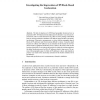Free Online Productivity Tools
i2Speak
i2Symbol
i2OCR
iTex2Img
iWeb2Print
iWeb2Shot
i2Type
iPdf2Split
iPdf2Merge
i2Bopomofo
i2Arabic
i2Style
i2Image
i2PDF
iLatex2Rtf
Sci2ools
PAM
2007
Springer
2007
Springer
Investigating the Imprecision of IP Block-Based Geolocation
The lack of adoption of a DNS-based geographic location service as proposed in RFC 1876 has lead to the deployment of alternative ways to locate Internet hosts. The two main alternatives rely either on active probing of individual hosts or on doing exhaustive tabulation of IP address ranges and their corresponding locations. Using active measurements, we show that the geographic span of blocks of IP addresses make their location difficult to choose. Using the single location for a block of IP addresses as an estimation of the location of its IP addresses leads to significant localization errors, whatever the choice made for the location of the block. Even using as the location of a block the one that minimizes the global localization error for all its IP addresses leads to large errors. The notion of the geographic span of a block of IP addresses is fuzzy, and depends in practice very much on the uncertainty associated to the location estimates of its IP addresses.
| Added | 09 Jun 2010 |
| Updated | 09 Jun 2010 |
| Type | Conference |
| Year | 2007 |
| Where | PAM |
| Authors | Bamba Gueye, Steve Uhlig, Serge Fdida |
Comments (0)

